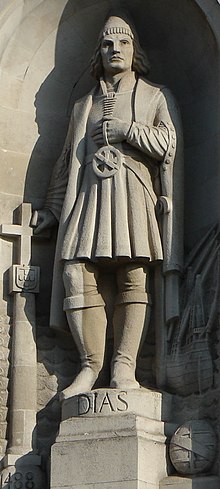History of South Africa
| Bartolomeu Dias | |
|---|---|

Statue of Bartolomeu Dias at the High Commission of South Africa in London. He was the first European navigator to sail around the southernmost tip of Africa.
|
 |
|
| Use | Civil and state flag, civil and state ensign |
|---|---|
| Design | The flag of Republic of South Africa was adopted on 27 April 1994. It replaced the flag that had been used since 1928 and was chosen to represent multiculturalism and ethnic diversity in the country's new, post-apartheid democratic order. |
The history of South Africa starts more than 100,000 years ago, when the first humans inhabited the region. The historical record of this ethnically diverse country is generally divided into five distinct periods: the pre-colonial era, the colonial era, the post-colonial and apartheid era, and the post-apartheid era. Much of this history, particularly of the colonial and post-colonial eras, is characterised by clashes of culture, violent territorial disputes between European settlers and indigenous people, dispossession and repression, and other racial and political tensions.
The discoveries of diamonds and gold in the 19th century had a profound effect on the fortunes of the region, propelling it onto the world stage and introducing a shift away from an exclusively agrarian-based economy towards industrialisation and the development of urban infrastructure. The discoveries also led to new conflicts culminating in open warfare between the Boer settlers and imperial Britain, fought essentially for control over the nascent South African mining industry.
Following the defeat of the Boers in the Anglo-Boer or South African War (1899–1902), the Union of South Africa was created as a dominion of the British Empire in terms of the South Africa Act 1909, which unified into one entity the four previously separate British colonies: Cape Colony, Natal Colony, Transvaal Colony and Orange River Colony. The country became a self-governing nation state within the British Empire in 1934 following enactment of the Status of the Union Act. The dominion came to an end on 31 May 1961 in consequence of a 1960 referendum, which legitimised the country becoming a sovereign state named Republic of South Africa. A republican constitution was adopted.
From 1948 to 1994, South African politics were dominated by Afrikaner nationalism. Racial segregation and white minority rule known officially as apartheid came into existence in 1960 and become an official law of segregation when South Africa become a Republic, an Afrikaans word meaning "separateness". It was an extension of segregationist legislation enacted in 1960. On 27 April 1994, after decades of armed struggle and international opposition to apartheid, during which military and political support was provided primarily by the Soviet Union to the non-racial African National Congress (ANC), the ANC achieved victory in the country's first democratic election. Since then the ANC has dominated the politics of the country in an uneasy alliance with the South African Communist Party and the Congress of South African Trade Unions.
...
Wikipedia
